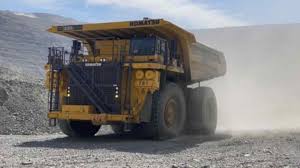Rare Metals & US Defense
The United States of America is directly doing large scale funding for critical mineral stockpiling and supply chain resilience as a core pillar of US national defense. Out of a USD $ 150 billion defense fund for the budget reconciliation approximately USD $ 2.5 billion has been allocated for domestic production and stockpiling of critical minerals. An additional $ 20 billion is allocated to strengthening munitions manufacturing and the broader defense industrial base which will also indirectly benefit critical minerals supply chains. If clear commercial pathways are accompanied by private sector investments only then will the desired goal of self-sufficiency in the critical mineral supply chain be achieved otherwise the supply chains remain fragile and strategically vulnerable.
 Credit;The New York Times
Credit;The New York Times
Critical Minerals Security for USA
Such enhanced funding can create durable markets with sustainable demand signals, actual commercial offtakes and price stability. Past experiences and stalled projects are a testimony to the fact that merely doling out subsidies and building stockpiles that gather dust is not enough. Recognising the national security risks posed by China’s stranglehold over critical mineral supply chains US President Donald Trump has issued an executive order that aims to significantly enhance domestic production. In the past the US has courted alternative critical mineral suppliers to diversify US supply chains. Presently the US is focusing on Central Asia namely Kazakhstan, Kyrgyzstan, Tajikistan, Turkmenistan and Uzbekistan viewed as a region well endowed with minerals resources .
Critical Minerals Dialogue
At the C5 +1 Critical Minerals Dialogue the Group of Seven’s (G7’s) Partnership for Global Investment and Infrastructure (PGII) and bilateral Memorandum of Understanding (MOU) signed with the region, the United States is exploring Central Asia’s untapped and largely unexplored critical energy mineral wealth despite the infrastructure, governance, topography, and geopolitical intricacies inherent in Central Asia based supply chains.
Central Asia New Frontier
Central Asia region possesses reserves of lithium, copper, aluminium and uranium although some reserves call for renewed exploratory efforts as the available and existing data was obtained during the Soviet era.
 Credit;Nikkei Asia
Credit;Nikkei Asia
Central Asian countries regional energy grids are neither well developed nor equipped to handle expanded mineral production. Mining is a highly energy intensive industry capturing almost 70 % of Kazakhstan’s industrial energy output. Central Asia’s power system is struggling to cope with the gap of generation and distribution and the grid frequently encounters high transmission losses and blackouts. Ensuring an uninterrupted and reliable power to mines and enrichment facilities requires modern power plants , upgraded high-voltage transmission lines the cost of which is estimated at $25 – 49 billion.Its almost established that subpar resource governance is impeding Central Asia’s mineral potential. Inconsistent tax regimes , lack of transparency, history of nationalising or renegogiating contracts with foreign companies and weak regulatory protections undermine the investment environment. A new entrant to the Central Asian market would encounter and have to overcome deeply entrenched Chinese and Russian influence in regional supply chains. No doubt the Soviet-era pipelines, highways and railways initially diverted trade northward after the collapse of the Soviet Union. China has caused a sort of rebound since 2013 as China’s Belt and Road Initiative (BRI) has reoriented trade eastward through infrastructure projects like the China- Kyrgyzstan – Uzbekistan entering into partnerships with regional transit operators like Kazakhstan Railways (KTZ) and also investing in locomotive construction and Caspian ports. China has brazenly procured regional transit infrastructure and influenced the investment bidding process. US businesses may encounter challenges in securing contracts in a region where critical infrastructure is under the influence of either China or Russia. Geopolitical and regulatory barriers limit Western access to the critical mineral resources of the Central Asian region. China holds the majority of mining permits in Kyrgyzstan and Tajikistan. Russia monopolizes the strategic and critical mineral sector and regional uranium enrichment. Some Central Asian mining companies have been sanctioned by the US for their intimate relationship with Russia. A capacity constraint in the critical minerals supply chain is of processing not mining. While Kazakhstan can refine copper, zinc and lead the region lacks processing capacity for energy minerals like lithium, uranium, nickel and cobalt therefore China or Russia are the preferred destinations for enrichment. China’s formal agreements in the Middle Corridor Multimodal Joint Venture, with Kazakhstan to construct the Tacheng-Avagoz Railway Line and China’s construction and management of Georgia’s Anakalia Deep Sea Port emphasise the commercially strategic significance of this route for China. Any increase in the route’s capacity by Western financing will paradoxically enhance the capacity of China’s westward exports. Any investment into the westward export of Central Asia’s critical minerals will benefit Chinese transit and open opportunities for the dumping of Chinese goods into Western markets.
China Dominating REE Supply Chain
China’s dominance in rare earth elements (REEs) has been a concern for the US since the early 2010’s. This year REEs became a key negotiating lever in the US-China relationship. Despite longstanding efforts, US dependence on China persists. Even with ample capital and guarantees, lead times stretch over years and are likely insufficient to ensure domestic US supply until 2028. Strategic stockpiles and recycling are inadequate and China holds ‘escalation dominance’ for the next 3-5 years, likely steering the Trump administration toward further tactical concessions versus China despite its hawkish rhetoric.
China, Russia, Brazil and Vietnam together account for roughly 83% of proven reserves and China possess nearly 50 % . Not to be outdone Australia is currently leading global REE exploration accounting for 43% of spending on new mining projects followed by Canada and Saudi Arabia yet geological availability does not equate to supply security. The real constraint lies in the ability to extract, separate individual REEs and process them at scale. The REEs do not occur in pure form being chemically bound within various minerals deposits often in low concentrations. Their nearly identical chemical properties make separation and purification complex and capital-intensive. Processing methods vary significantly across deposits affecting cost structures and environmental harm criteria. In practice, separation processes must often be tailored to the specific mineralogy of each deposit, implying long lead times and requirement of technical expertise . China controls both the upstream deposits and nearly all the downstream separation capacity. The US Department of Defense aims to establish a complete mine-to-magnet REE supply chain by the year 2027 to address gaps in US national defence needs requiring defence contractors to avoid importing from China . Though the “rare” in the name implies scarcity, rare earth elements are actually fairly abundant in the Earth’s crust. It is difficult to locate deposits concentrated enough to make mining for them financially viable. For the next decade or so the West will remain dependent on China for rare earths and critical minerals due to China’s dominance in processing and lengthy timelines for operationalising mines and refining projects. The US government will continue to promote domestic critical mineral extraction and refining projects, but such initiatives face environmental activism and legal challenges. Artificial intelligence and research breakthroughs, however, will accelerate Western firms’ ability to identify and develop non-rare earth magnets and other supply alternatives. Mining and refining projects typically take over 15 years to become fully operational.
Energy Transition to Renewables
Rare earth elements (REE) remain key enablers for the ongoing energy and environmental transition being critical raw materials in many low-carbon technologies. In the past few years, many new REE projects have been developed worldwide to replenish the market, and thus are changing the supply chains. Comprehensive data in the public domain is lacking regarding these projects, impeding investors and policymakers from having a clear view of the global supply of REE. Among those projects, carbonatite type deposits are the main sources and most likely will dominant future targets for exploration and mining. Asia remains the largest source of REE but Greenland, Africa, and Europe display significant resource potential if environmental issues and processing technologies are adequately addressed. Rare earth metals refers to a group of 17 chemical elements including 15 lanthanides with the addition of scandium (Sc) and yttrium (Y), as defined by the International Union of Pure and Applied Chemistry. Excluding chemically distinct Sc, REE’s are divided into light rare earth elements (LREE) and heavy rare earth elements (HREE) based on atomic mass.
Energy Minerals and Environmental Concerns
Although raw minerals can be transported to processors in the West the westward routes are largely underdeveloped. A peculiar feature of the region is that it is surrounded by sanctioned and adversarial states namely Afghanistan, China, Iran and Russia leaving the ” Middle Corridor ” as the only viable multimodal transport and sanction free export route connecting Central Asia to Europe via the Caspian Sea and South Caucasus. However, due to regional infrastructure inefficiencies and checkered contractual practices and rapidly developing environmental issues Western investors have been slow to develop the route’s capacity.
Railway Gauge and Transportation Capacity
Infrastructure barriers in Central Asia have kept the route’s container capacity low , shipping times unpredictable , frequent delays and volatility of prices . Caspian ports are restrained by low vessel capacity, time-consuming ” break of gauge ” common across Central Asian railways, unaligned tariff regimes, cargo regulations and cumbersome customs procedures impeding the flow of minerals across borders.
Climate & Caspian Water Loss
 Credit;Times of Central Asia
Credit;Times of Central Asia
It is anticipated that climate driven water loss may result in lowering of the Caspian shoreline by 21 m and the port capacity is expected to shrink further. The ports could retreat at least 1 km from the shoreline eventually leading to significant redevelopment with its accompanying economic costs . Rising temperatures and the construction of dams along Russia’s Volga River, the Caspian main source of water, have seen the average sea level drop thereby reducing cargo ship capacity by 20 %. In the northeast Caspian, where waters are shallow, ships sail from ports before they are fully loaded in order to reduce ship depth or draught . If waters decline further, northeast Caspian ports will likely be unusable. Desalination projects have been implemented by Kazakhstan, Azerbaijan and Turkmenistan to slow the declining water levels of the Caspian. The energy intensive desalination process has unintended negative impacts on marine life and water quality with questionable ability to slow declining water levels .
Logistical Uncertainty across Central Asian Critical Mineral Mining Transit Routes & Hubs
Studies indicate that around Euros 19.5 billion is required to ensure commercial viability as transport costs remain high, delays create logistical uncertainty and limited domestic processing makes reliance on neighbouring markets compulsory. Unified tariffs and cargo regulations and the digitalisation of regional transit are likely to reduce delays along the Middle Corridor incentivising additional infrastructure investments.
US Securing Critical Minerals amid Infrastructural, logistical, Environmental & Legal Challenges
Apparently the US strategically benefits from engaging with Central Asia and offering itself as an alternative partner investing into regional transit routes which may lead to negative unintended consequences. Such transit routes require massive infrastructure investments and significant regulatory improvements in order to benefit Western markets . Securing of critical mineral ventures is vital to US efforts to reduce dependence on China in the short and medium term. Low export capacity, high transit costs, geopolitical volatility and a high-risk investment environment significantly reduces the region’s commercial viability for Western interests. Transporting critical and energy minerals across oceans necessarily involves infrastructural, logistical, environmental and legal complexities which the US has to trade off with the time sensitive nature of US critical mineral needs . Perhaps US-allied countries with established mineral export industries like Canada or Chile should be explored as part of an integral US supply chain based on capacity, reliability and economic viability.
Author : Nadir Mumtaz
Sources/Credit

Leave A Comment